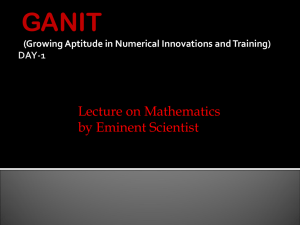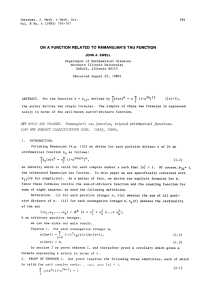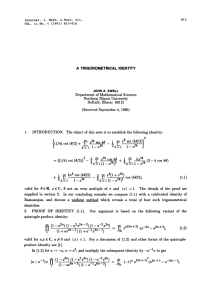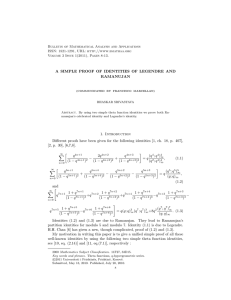SOME THETA FUNCTIONS IDENTITIES ASSOCIATED WITH THE Zhi-Guo Liu
advertisement
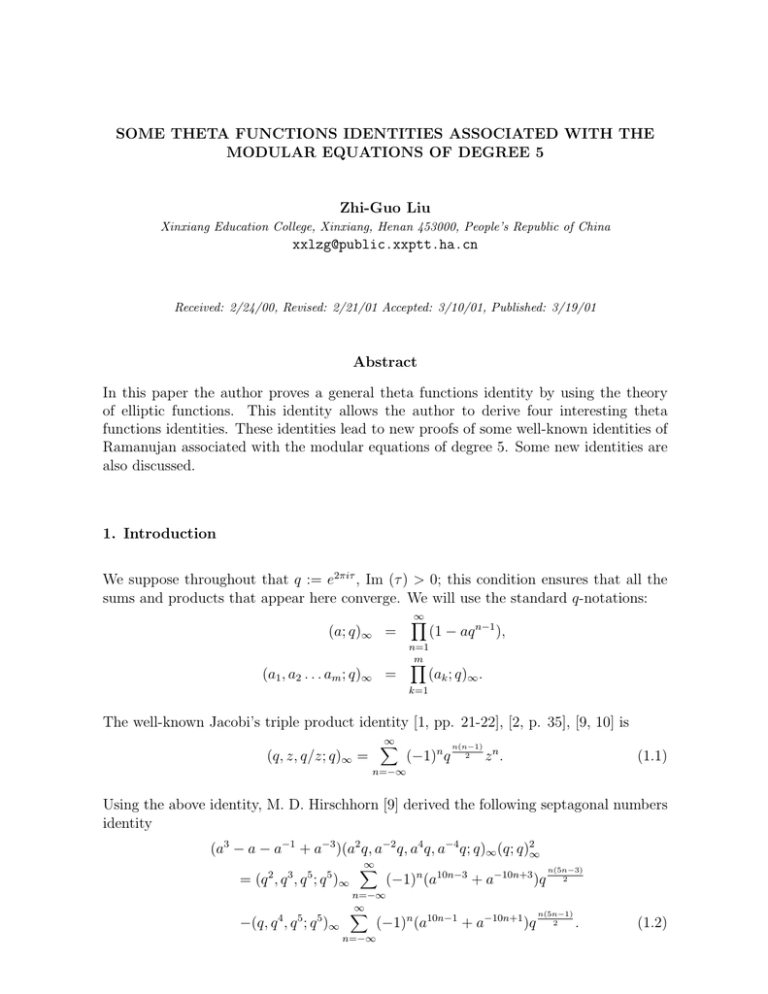
SOME THETA FUNCTIONS IDENTITIES ASSOCIATED WITH THE
MODULAR EQUATIONS OF DEGREE 5
Zhi-Guo Liu
Xinxiang Education College, Xinxiang, Henan 453000, People’s Republic of China
xxlzg@public.xxptt.ha.cn
Received: 2/24/00, Revised: 2/21/01 Accepted: 3/10/01, Published: 3/19/01
Abstract
In this paper the author proves a general theta functions identity by using the theory
of elliptic functions. This identity allows the author to derive four interesting theta
functions identities. These identities lead to new proofs of some well-known identities of
Ramanujan associated with the modular equations of degree 5. Some new identities are
also discussed.
1. Introduction
We suppose throughout that q := e2πiτ , Im (τ ) > 0; this condition ensures that all the
sums and products that appear here converge. We will use the standard q-notations:
∞
Y
(a; q)∞ =
(1 − aq n−1 ),
n=1
m
Y
(a1 , a2 . . . am ; q)∞ =
(ak ; q)∞ .
k=1
The well-known Jacobi’s triple product identity [1, pp. 21-22], [2, p. 35], [9, 10] is
∞
X
(q, z, q/z; q)∞ =
(−1)n q
n(n−1)
2
zn.
(1.1)
n=−∞
Using the above identity, M. D. Hirschhorn [9] derived the following septagonal numbers
identity
(a3 − a − a−1 + a−3 )(a2 q, a−2 q, a4 q, a−4 q; q)∞ (q; q)2∞
2
3
5
5
= (q , q , q ; q )∞
∞
X
(−1)n (a10n−3 + a−10n+3 )q
n(5n−3)
2
n=−∞
−(q, q 4 , q 5 ; q 5 )∞
∞
X
(−1)n (a10n−1 + a−10n+1 )q
n=−∞
n(5n−1)
2
.
(1.2)
2
INTEGERS: ELECTRONIC JOURNAL OF COMBINATORIAL NUMBER THEORY 1(2001), #A03
Using this identity, Hirschhorn provided a simpler proof of the following identity of
Ramanujan [13, p. 139], [4, 9, 16]:
1−5
∞ µ ¶
X
n
nq n
n=1
where
³ ´
n
5
5
1 − qn
=
(q; q)5∞
,
(q 5 ; q 5 )∞
(1.3)
denote the Legendre symbol.
In [7], H. M. Farkas and I. Kra rediscovered (1.2) using the theory of theta functions
with rational characteristics. F. G. Garvan [6] provided an interesting generalization of
(1.2) and his proof depends only on the triple product identity.
Using the Jacobi theta function θ1 (z|q) ((2.1) below), (1.2) can be reformulated as
iq − 2 θ1 (x|q)θ1 (2x|q) = θ1 (2πτ |q 5 ) {e2ix θ1 (5x + πτ |q 5 ) − e−2ix θ1 (5x − πτ |q 5 )}
−θ1 (πτ |q 5 ) {e4ix θ1 (5x + 2πτ |q 5 ) − e−4ix θ1 (5x − 2πτ |q 5 )} . (1.4)
1
In Section 3 of this paper we will prove a very general identity (identity (3.2) below)
involving theta functions.
In Section 4, we will derive (1.4) from identity (3.2), and then prove (1.3) using (1.4).
We will also prove the following important result of Ramanujan:
1
(q; q)∞
5
−
1
−
R(q
)
=
,
R(q 5 )
q(q 25 ; q 25 )∞
where
q − 5 R(q) =
1
(1.5)
(q, q 4 ; q 5 )∞
.
(q 2 , q 3 ; q 5 )∞
(1.6)
The following identity will be established in Section 5 using (3.2):
½
2π
π
5θ1 (x|q )θ1 (2x|q ) = θ1 ( |q) θ1 (x + |q) − θ1 (x −
5
5
½
π
2π
|q) − θ1 (x −
− θ1 ( |q) θ1 (x +
5
5
5
5
¾
π
|q)
5
¾
2π
|q) .
5
(1.7)
From this identity, we can obtain the following identity of Ramanujan [13, p. 139], [4, 16]:
∞ µ ¶
X
n
n=1
5
(q 5 ; q 5 )5∞
qn
=
q
.
(1 − q n )2
(q; q)∞
(1.8)
Using (1.7), we can also derive the identity
θ1 ( π5 |q)
|q)
θ1 ( 2π
(q 25 ; q 25 )∞
5
−
.
=
1
+
5q
π
θ1 ( 5 |q)
(q; q)∞
θ1 ( 2π
|q)
5
(1.9)
INTEGERS: ELECTRONIC JOURNAL OF COMBINATORIAL NUMBER THEORY 1(2001), #A03
3
In Section 6, we will prove
2π
θ15 ( |q)
½
¾
π
π
C(q)θ1 (x|q)θ1 (2x|q) =
+ |q) − θ15 (x − |q)
5
5
5
½
¾
π
2π
2π
|q) − θ15 (x −
|q) ,
−θ15 ( |q) θ15 (x +
5
5
5
θ15 (x
where
C(q) = 250q(q; q)4∞ (q 5 ; q 5 )4∞ + 3125q 2
(q 5 ; q 5 )10
∞
,
(q; q)2∞
(1.10)
(1.11)
Using (1.10), we can obtain
θ15 ( 2π
|q)
θ15 ( π5 |q)
(q 5 ; q 5 )6∞
5
−
.
=
11
+
125q
θ15 ( π5 |q)
(q; q)6∞
θ15 ( 2π
|q)
5
(1.12)
Section 7 is devoted to the proof of the following identity:
C(q)θ1 (x|q 5 )θ1 (2x|q 5 ) = θ15 (2πτ |q 5 ) {e2ix θ15 (x + πτ |q 5 ) − e−2ix θ15 (x − πτ |q 5 )}
(1.13)
5
5
4ix 5
5
−4ix 5
5
−θ1 (πτ |q ) {e θ1 (x + 2πτ |q ) − e
θ1 (x − 2πτ |q )} , (1.14)
where
5
q 2 C(q) = 10q(q; q)4∞ (q 5 ; q 5 )4∞ +
(q; q)10
∞
.
(q 5 ; q 5 )2∞
(1.15)
Using this identity, we can rederive the following identity of Ramanujan:
1
(q; q)6∞
5
−
11
−
R
(q)
=
.
R5 (q)
q(q 5 ; q 5 )6∞
(1.16)
It should be pointed out that we also need the method of L. -C. Shen [17] in deriving
(1.4), (1.7), (1.10) and (1.14).
Identities (1.5) and (1.16) can be found in Ramanujan’s second notebook [14, pp.
265-267] and were first proved by G. N. Watson [18] for the purpose of establishing
some of Ramanujan’s claims about R(q) made in his first two letters to Hardy [15, pp.
xxvii, xxviii]. They were used by B. C. Berndt, H. H. Chan, and L. -C. Zhang [3] in
deriving general formulas for the explicit evaluation of R(q). They were also used by the
author and R. P. Lewis [11] to provide simpler proofs of two Lambert series identities of
Ramanujan.
In [4], Chan utilized the Hecke correspondence between Dirichlet series and Fourier
expansions of modular forms to show that (1.3) and (1.4) are equivalent.
INTEGERS: ELECTRONIC JOURNAL OF COMBINATORIAL NUMBER THEORY 1(2001), #A03
4
2. Some Basic Facts About θ1 (z|q)
For q = e2πiτ , with Im(τ ) > 0, the Jacobi theta function θ1 (z|q) is defined by [19, p. 463]
1
θ1 (z|q) : = −iq 8
∞
X
1
(−1)n q 2 n(n+1) e(2n+1)iz
n=−∞
1
= 2q 8
∞
X
1
(−1)n q 2 n(n+1) sin(2n + 1)z.
(2.1)
n=0
In terms of infinite products [19, p. 469],
θ1 (z|q) = 2q 8 (sin z)(q; q)∞ (qe2iz ; q)∞ (qe−2iz ; q)∞
1
= iq 8 e−iz (q; q)∞ (e2iz ; q)∞ (qe−2iz ; q)∞ .
1
(2.2)
One deduces easily from (2.1) that (see, for example, [17])
∂θ1
∂ 2 θ1
.
= −8q
2
∂z
∂q
(2.3)
In the following, θ10 and θ100 denote the first and second partial derivatives of θ1 with
respect to z. We can derive the following two important identities [17] from (2.2):
∞
X
θ10
qn
(z|q) = cot z + 4
sin 2nz,
n
θ1
n=1 1 − q
(2.4)
∞
∞
∞
X
X
X
nq n e2iz
nq n e−2iz
nq n
θ100
(z|q) = −1 + 8
+
8
+
8
n 2iz
n −2iz
n
θ1
n=1 1 − q e
n=1 1 − q e
n=1 1 − q
∞
∞
X
X
qn
nq n
= −1 + 16
cos
2nz
+
8
.
n 2
n
n=1 (1 − q )
n=1 1 − q
(2.5)
Differentiating (2.4) with respect to z, we obtain
Ã
θ10
θ1
!0
∞
X
nq n
(z|q) = − csc z + 8
cos 2nz.
n
n=1 1 − q
2
(2.6)
Using these identities and the simple differential identity
0
(θ10 /θ1 ) = θ100 /θ1 − (θ10 /θ1 ) ,
2
(2.7)
an interesting proof of the following trigonometric series identity of Ramanujan [12], [8,
pp. 134-135] has recently been given by Shen [17]:
(
½
=
∞
X
1
q n sin 2nz
cot z +
n
4
n=1 1 − q
1
cot z
4
¾2
+
)2
∞
X
q n cos 2nz
n=1
∞
nq n (1 − cos 2nz)
1X
+
.
(1 − q n )2
2 n=1
1 − qn
(2.8)
INTEGERS: ELECTRONIC JOURNAL OF COMBINATORIAL NUMBER THEORY 1(2001), #A03
5
By some elementary calculations we find the following trigonometric functions identities:
π
2π
4
− csc2
= √ ,
5
5
5
√ µ ¶
5 n
4nπ
2nπ
− cos
=
.
cos
5
5
2 5
csc2
(2.9)
(2.10)
in (2.4) respectively and then subtracting the two resulting
Replacing z by π5 and 2π
5
equations and finally using (2.9) we find that
θ100
θ1
µ ¯ ¶
µ
¶
∞ µ ¶
√ X
θ100 2π ¯¯
π¯
n
¯q −
¯q = 8 5
5
θ1
5
n=1
5
qn
.
(1 − q n )2
(2.11)
in (2.5) respectively and then subtracting the two resulting
Replacing z by π5 and 2π
5
equations and finally using (2.9), (2.10) and (1.3) we find that
Ã
θ10
θ1
!0 µ
¶
Ã
π ¯¯
θ10
¯q −
5
θ1
!0 µ
2π ¯¯
¯q
5
¶
(
µ ¶
∞
X
4
n
nq n
= −√ 1 − 5
1 − qn
5
n=1 5
4 (q; q)5∞
= −√
.
5 (q 5 ; q 5 )∞
)
(2.12)
Applying logarithmic differentiation to (2.2), we find that
∞
∞
X
X
q n e2iz
q n e−2iz
θ10
(z|q) = −i − 2i
+
2i
.
n 2iz
n −2iz
θ1
n=0 1 − q e
n=1 1 − q e
(2.13)
Differentiating (2.13) with respect to z, we find that
Ã
θ10
θ1
!0
∞
X
∞
X
q n e2iz
q n e−2iz
(z|q) = 4
+
4
.
n 2iz 2
n −2iz )2
n=0 (1 − q e )
n=1 (1 − q e
(2.14)
Replacing q by q 5 , setting z = πτ and z = 2πτ respectively, we obtain
Ã
Ã
θ10
θ1
θ10
θ1
!0
(πτ |q 5 ) = 4
!0
(2πτ |q 5 ) = 4
∞
X
∞
X
q 5n+1
q 5n+4
+
4
,
5n+1 )2
5n+4 )2
n=0 (1 − q
n=0 (1 − q
∞
X
∞
X
q 5n+2
q 5n+3
+
4
.
5n+2 )2
5n+3 )2
n=0 (1 − q
n=0 (1 − q
Therefore, we have
Ã
θ10
θ1
!0
Ã
θ0
(πτ |q ) − 1
θ1
5
!0
(2πτ |q 5 ) = 4
∞ µ ¶
X
n
n=1
5
qn
.
(1 − q n )2
(2.15)
INTEGERS: ELECTRONIC JOURNAL OF COMBINATORIAL NUMBER THEORY 1(2001), #A03
6
From (2.1), we find that
∞
X
1
e2iz θ1 (5z + πτ |q 5 ) = iq 8
(−1)n q
n=−∞
∞
X
e4iz θ1 (5z + 2πτ |q 5 ) = iq − 8
3
n(5n−3)
2
(−1)n q
e(10n−3)iz ,
n(5n−1)
2
(2.16)
e(10n−1)iz .
(2.17)
n=−∞
Differentiating both sides of (2.16) twice with respect to z, and then setting z = 0 in
the resulting equation, we obtain
−4θ1 (πτ |q 5 ) + 20iθ10 (πτ |q 5 ) + 25θ100 (πτ |q 5 )
= −iq
∞
X
1
8
(−1)n (10n − 3)2 q
n=−∞
Ã
= −iq
1
8
d
9 + 40q
dq
Ã
1
= −iq 8 9 + 40q
!
!
∞
X
n(5n−3)
2
(−1)n q
n(5n−3)
2
n=−∞
d
(q, q 4 , q 5 ; q 5 )∞ .
dq
(2.18)
By logarithmic differentiation, we have
Ã
!
d
(q, q 4 , q 5 ; q 5 )−1
9 + 40q
(q, q 4 , q 5 ; q 5 )∞
∞
dq
Ã
!
∞
X
5nq 5n
(5n − 4)q 5n−4 (5n − 1)q 5n−1
= 9 − 40
+
+
.
5n
1 − q 5n−4
1 − q 5n−1
n=1 1 − q
(2.19)
Substituting (2.19) into (2.18) and using (2.24) below we obtain
θ00
θ10
(πτ |q 5 ) − 25 1 (πτ |q 5 )
θ1
θ1
Ã
!
∞
5n
X
(5n − 4)q 5n−4 (5n − 1)q 5n−1
5nq
= 9 − 40
+
+
.
5n
1 − q 5n−4
1 − q 5n−1
n=1 1 − q
4 − 20i
(2.20)
Similarly, from (2.17) we obtain
θ00
θ10
(2πτ |q 5 ) − 25 1 (2πτ |q 5 )
θ1
θ1
Ã
!
∞
5n
X
5nq
(5n − 3)q 5n−3 (5n − 2)q 5n−2
= 1 − 40
+
+
.
5n
1 − q 5n−3
1 − q 5n−2
n=1 1 − q
16 − 40i
(2.21)
Substracting (2.20) from (2.21) we obtain
(
)
(
)
θ0
θ00
θ0
θ00
12 + 20i 1 (πτ |q 5 ) − 2 1 (2πτ |q 5 ) + 25 1 (πτ |q 5 ) − 1 (2πτ |q 5 )
θ1
θ1
θ1
θ1
(
)
µ
∞
X n ¶ nq n
= −8 1 − 5
.
1 − qn
n=1 5
(2.22)
INTEGERS: ELECTRONIC JOURNAL OF COMBINATORIAL NUMBER THEORY 1(2001), #A03
7
Differentiating (2.2) with respect to z and then putting z = 0 we obtain the identity
θ10 (q) := θ10 (0|q) = 2q 8 (q; q)3∞ .
1
(2.23)
Replacing q by q 5 in (2.2) and then taking z = πτ , and 2πτ in the resulting equation
respectively we find that
1
θ1 (πτ |q 5 ) = iq 8 (q; q 5 )∞ (q 4 ; q 5 )∞ (q 5 ; q 5 )∞ ,
θ1 (2πτ |q ) = iq
5
− 38
2
5
3
5
5
(2.24)
5
(q ; q )∞ (q ; q )∞ (q ; q )∞ .
(2.25)
Multiplying the above two equations, after some manipulation we find that
θ1 (πτ |q 5 )θ1 (2πτ |q 5 ) = −q − 4 (q; q)∞ (q 5 ; q 5 )∞ .
1
(2.26)
From (2.2) we have the following special values of θ1 (z|q)
−2πi
1
2πi
2π
π
|q) = 2q 8 (sin )(q; q)∞ (qe 5 ; q)∞ (qe 5 ; q)∞ ,
5
5
−4πi
1
4πi
2π
π
θ1 ( |q) = 2q 8 (sin )(q; q)∞ (qe 5 ; q)∞ (qe 5 ; q)∞ .
5
5
θ1 (
(2.27)
(2.28)
Multiplying the above equations and then using the elementary facts
√
π
2π
5
sin sin
=
5
5
4
and
(1 − x)(1 − xe
2πi
5
)(1 − xe
2πi
5
)(1 − xe
2πi
5
)(1 − xe
2πi
5
) = 1 − x5 ,
in the resulting equation, we find that
√ 1
π
2π
θ1 ( |q)θ1 ( |q) = 5q 4 (q; q)∞ (q 5 ; q 5 )∞ .
5
5
(2.29)
From the definition of θ1 (z|q) we readily find the following functional equations
θ1 (z + nπ|q) = (−1)n θ1 (z|q),
θ1 (z + nπτ |q) = (−1)n q
2
− n2
(2.30)
e−2nπiz θ1 (z|q),
(2.31)
where n is any integer. Differentiating the above equations with respect to z and then
setting z = 0 in the resulting equations, we find that
n2
θ10 (nπ|q) = (−1)n θ10 (q) and θ10 (nπτ |q) = (−1)n q − 2 θ10 (q).
(2.32)
INTEGERS: ELECTRONIC JOURNAL OF COMBINATORIAL NUMBER THEORY 1(2001), #A03
8
3. A General Identity For θ1 (z|q)
In this section we will prove the following theta functions identity.
Theorem 1 If f1 (z) and f2 (z) are two different entire functions satisfying the functional
equations
5
f (z + π) = −f (z)
and
f (z + πτ ) = −q − 2 e−10iz f (z),
(3.1)
with f1 (0) 6= 0, f2 (0) 6= 0, then there is a constant C(q) such that
C(q)θ1 (x|q)θ1 (2x|q) = f2 (0) (f1 (x) + f1 (−x)) − f1 (0) (f2 (x) + f2 (−x)) .
(3.2)
To prove the above identity we require the following fundamental theorem of elliptic
functions [5, p. 22, Theorem 2]:
Theorem 2 The sum of all the residues of an elliptic function vanishes in the period
parallelogram.
The idea is to construct an elliptic function whose poles are known and then compute
the residues of the elliptic function at these poles. Set the sum of the residues to zero to
obtain the desired identity for theta functions. We will use L’Hôpital’s rule to compute
the residues.
Proof. Let 0 < x, y < π be two distinct parameters different from the zeros of f1 (z). By
(2.31) and (2.32) we readily verify that
θ1 (z|q)θ1 (z − x|q)θ1 (z + x|q)θ1 (z − y|q)θ1 (z + y|q)
satisfies (3.1). Therefore,
E(z) =
f1 (z)
,
θ1 (z|q)θ1 (z − x|q)θ1 (z + x|q)θ1 (z − y|q)θ1 (z + y|q)
is an elliptic function with periods π and πτ . The poles of E(z) are 0, x, π − x, y, and
π − y, all of which are simple poles. Let res(E; α) denote the residue of E(z) at α. From
Theorem 2, we have
res(E; 0) + res(E; x) + res(E; π − x) + res(E; y) + res(E; π − y) = 0.
(3.3)
Now
res(E; 0) = lim zE(z)
z→0
f1 (z)
z
× lim
z→0 θ1 (z − x|q)θ1 (z + x|q)θ1 (z − y|q)θ1 (z + y|q)
z→0 θ1 (z|q)
f1 (0)
.
(3.4)
= 0
2
θ1 (q)θ1 (x|q)θ12 (y|q)
= lim
INTEGERS: ELECTRONIC JOURNAL OF COMBINATORIAL NUMBER THEORY 1(2001), #A03
9
res(E; x) = lim (z − x)E(z)
z→x
f1 (z|q)
z−x
× lim
z→x θ (z|q)θ (z + x|q)θ (z − y|q)θ (z + y|q)
z→x θ (z − x|q)
1
1
1
1
1
f1 (x)
.
(3.5)
= 0
θ1 (q)θ1 (x|q)θ1 (2x|q)θ1 (x − y|q)θ1 (x + y|q)
= lim
res(E; π − x) =
lim (z − π + x)E(z)
z→π−x
f1 (z)
z−π+x
× lim
z→π−x
θ1 (z|q)θ1 (z − x|q)θ1 (z − y|q)θ1 (z + y|q)
θ1 (z + x|q)
f1 (π − x)
= − 0
θ1 (π|q)θ1 (π − x|q)θ1 (π − 2x|q)θ1 (π − x − y|q)θ1 (π − x + y|q)
f1 (−x)
.
(3.6)
= 0
θ1 (q)θ1 (x|q)θ1 (2x|q)θ1 (x − y|q)θ1 (x + y|q)
=
lim
z→π−x
Similarly, we have
res(E; y) = −
res(E; π − y) = −
f1 (y)
0
θ1 (q)θ1 (y|q)θ1 (2y|q)θ1 (x
− y|q)θ1 (x + y|q)
f1 (−y)
0
θ1 (q)θ1 (y|q)θ1 (2y|q)θ1 (x −
y|q)θ1 (x + y|q)
,
(3.7)
.
(3.8)
Substituting (3.5), (3.6), (3.7) and (3.8) into (3.3) we obtain
f1 (y) + f1 (−y)
f1 (x) + f1 (−x)
θ1 (x + y|q)θ1 (x − y|q)
−
=
.
f1 (0)θ1 (y|q)θ1 (2y|q)
f1 (0)θ1 (x|q)θ1 (2x|q)
θ12 (x|q)θ12 (y|q)
(3.9)
In the same way we can obtain the identity for f2 (z):
f2 (x) + f2 (−x)
θ1 (x + y|q)θ1 (x − y|q)
f2 (y) + f2 (−y)
−
=
. (3.10)
f2 (0)θ1 (y|q)θ1 (2y|q)
f2 (0)θ1 (x|q)θ1 (2x|q)
θ12 (x|q)θ12 (y|q)
By comparing (3.9) and (3.10), we obtain
f1 (x) + f1 (−x)
f2 (x) + f2 (−x)
−
f1 (0)θ1 (x|q)θ1 (2x|q) f2 (0)θ1 (x|q)θ1 (2x|q)
f2 (y) + f2 (−y)
f1 (y) + f1 (−y)
−
.
=
f1 (0)θ1 (y|q)θ1 (2y|q) f2 (0)θ1 (y|q)θ1 (2y|q)
From this identity we readily find that
f2 (x) + f2 (−x)
f1 (x) + f1 (−x)
−
f1 (0)θ1 (x|q)θ1 (2x|q) f2 (0)θ1 (x|q)θ1 (2x|q)
(3.11)
INTEGERS: ELECTRONIC JOURNAL OF COMBINATORIAL NUMBER THEORY 1(2001), #A03
10
C(q)
is independent of x, so it must be a constant, say f1 (q)f
. This completes the proof of
2 (q)
Theorem 1. By analytic continuation, we know (3.2) holds for all x.
Identity (3.2) is a very general identity involving theta functions. In the next sections
we will choose some special functions f1 (z) and f2 (z) to obtain some interesting identities
for theta functions.
4. The Proofs of (1.3), (1.4), and (1.5)
Using (2.31), it is easy to verify that f1 (z) = e2iz θ1 (5z + πτ |q 5 ) and f2 (z) = e4iz θ1 (5z +
2πτ |q 5 ) satisfy all the conditions of Theorem 1. Taking f1 (z) = e2iz θ1 (5z + πτ |q 5 ) and
f2 (z) = e2iz θ1 (5z + 2πτ |q 5 ) in Theorem 1, we find that
C(q)θ1 (x|q)θ1 (2x|q) = θ1 (2πτ |q 5 ) {e2ix θ1 (5x + πτ |q 5 ) − e−2ix θ1 (5x − πτ |q 5 )}
−θ1 (πτ |q 5 ) {e4ix θ1 (5x + 2πτ |q 5 ) − e−4ix θ1 (5x − 2πτ |q 5 )} . (4.1)
To determine C(q), we take x =
π
5
in (4.1). After some simple calculations we find that
π
2π
4π
2π
C(q)θ1 ( |q)θ1 ( |q) = 2i(cos
− cos )θ1 (πτ |q 5 )θ1 (2πτ |q 5 ).
5
5
5
5
(4.2)
Substituting (2.26) and (2.29) into the above identity we find that
1
1
2π
4π
2
− cos )q − 2 = iq − 2 .
C(q) = √ i(cos
5
5
5
(4.3)
Using (4.3) in (4.1) we obtain (1.4).
Replacing q by q 5 , setting x = πτ , and using (2.25) we obtain (1.5).
Differentiating both sides of (1.4) twice with respect to x and setting x = 0, we find
that
(
)
(
)
θ0
θ00
θ0
θ00
12 + 20i 1 (πτ |q 5 ) − 2 1 (2πτ |q 5 ) + 25 1 (πτ |q 5 ) − 1 (2πτ |q 5 )
θ1
θ1
θ1
θ1
4q − 4 θ10 (q)2
.
=
θ1 (πτ |q 5 )θ1 (2πτ |q 5 )
1
Substituting (2.22), (2.23), and (2.26) into the above identity we obtain (1.3).
5. The Proofs of (1.7), (1.8), and (1.9)
1
Taking f1 (z) = θ1 (z + π5 |q 5 ) and f2 (z) = θ1 (z +
2π 15
|q )
5
in Theorem 1, we find that
(4.4)
INTEGERS: ELECTRONIC JOURNAL OF COMBINATORIAL NUMBER THEORY 1(2001), #A03
½
11
¾
2π 1
π 1
π 1
|q 5 ) θ1 (x + |q 5 ) − θ1 (x − |q 5 )
5
5
5
½
¾
π 1
2π 1
2π 1
|q 5 ) − θ1 (x −
|q 5 ) .
−θ1 ( |q 5 ) θ1 (x +
5
5
5
C(q)θ1 (x|q)θ1 (2x|q) = θ1 (
Replacing q by q 5 we obtain
½
¾
2π
π
π
C(q )θ1 (x|q )θ1 (2x|q ) = θ1 ( |q) θ1 (x + |q) − θ1 (x − |q)
5
5
5
½
¾
π
2π
2π
|q) − θ1 (x −
|q) .
−θ1 ( |q) θ1 (x +
5
5
5
5
5
(5.1)
5
(5.2)
To determine C(q 5 ), we take x = πτ in (5.2). Using (2.31), after some simple calculations, we find that
2π
4π
π
2π
− cos )θ1 ( |q)θ1 ( |q).
5
5
5
5
Substituting (2.26) and (2.29) into the above identity we find that
√
1
4π
2π
C(q 5 ) = 2 5(cos
− cos )q − 2 = 5.
5
5
Using (5.4) in (5.2) we obtain (1.7).
C(q 5 )θ1 (πτ |q 5 )θ1 (2πτ |q 5 ) = 2q − 2 (cos
1
Setting x =
π
5
(5.3)
(5.4)
in (1.7) and using (2.29) we obtain (1.8).
Differentiating both sides of (1.7) twice with respect to x and setting x = 0, we find
that
µ
¶
µ
¶
θ100 2π ¯¯
10θ10 (q 5 )2
θ100 π ¯¯
.
(5.5)
¯q −
¯q =
θ1 5
θ1 5
θ1 ( π5 |q)θ1 ( 2π
|q)
5
Substituting (2.11), (2.23), and (2.29) in the above identity we obtain (1.9)
6. The Proofs of (1.10) and (1.12)
Taking f1 (z) = θ15 (z + π5 |q) and f2 (z) = θ15 (z +
2π
θ15 ( |q)
½
2π
|q)
5
in Theorem 1, we find that
¾
π
π
+ |q) − θ15 (x − |q)
C(q)θ1 (x|q)θ1 (2x|q) =
5
5
5
½
¾
2π
2π
5 π
5
5
|q) − θ1 (x −
|q) .
−θ1 ( |q) θ1 (x +
5
5
5
θ15 (x
(6.1)
Differentiating both sides of (6.1) twice with respect to x and setting x = 0, we find
that
θ100
θ1
à !2 µ
à !2 µ
µ ¯ ¶
µ
¶
¶
¶
θ100 2π ¯¯
π¯
θ10
π ¯¯
θ10
2π ¯¯
¯q −
¯q + 4
¯q − 4
¯q =
5
θ1
5
θ1
5
θ1
5
2C(q)θ10 (q)2
. (6.2)
5θ15 ( π5 |q)θ15 ( 2π
|q)
5
INTEGERS: ELECTRONIC JOURNAL OF COMBINATORIAL NUMBER THEORY 1(2001), #A03
12
Using (2.7) we have
(
θ00
5 1
θ1
(Ã !0µ
µ ¯ ¶
µ
¶)
¶ Ã 0 !0µ
¶)
π¯
θ10
π ¯¯
θ1
2π ¯¯
θ100 2π ¯¯
−4
=
¯q −
¯q
¯q −
¯q
5
θ1
5
θ1
5
θ1
5
2C(q)θ10 (q)2
. (6.3)
5θ15 ( π5 |q)θ15 ( 2π
|q)
5
Substituting (2.11), (2.12), (2.23) and (2.29) into the above equation we obtain
(
∞ µ ¶
∞ µ ¶
√ X
X
n
qn
n
nq n
16
√
−
1
−
5
40 5
(1 − q n )2
1 − qn
5
n=1 5
n=1 5
)
=
8q −1 C(q)(q; q)∞
√
.
125 5(q 5 ; q 5 )5∞
(6.4)
Substituting (1.3) and (1.8) into the above equation we obtain
C(q) =
250q(q; q)4∞ (q 5 ; q 5 )4∞
; q 5 )10
∞
+ 3125q
,
2
(q; q)∞
2 (q
π
5
thereby completing the proof of (1.10). Taking x =
(1.12).
5
(6.5)
in (1.10) and using (2.29) we obtain
7. The Proofs of (1.14) and (1.16)
Taking f1 (z) = e2iz θ15 (z +
πτ
|q)
5
and f2 (z) = e4iz θ15 (z +
2πτ
|q)
5
in Theorem 1, we find that
½
¾
2πτ
πτ
πτ
|q) e2ix θ15 (x +
|q) − e−2ix θ15 (x −
|q)
5
5
5
½
¾
2πτ
2πτ
5 πτ
4ix 5
−4ix 5
|q) − e
|q) . (7.1)
−θ1 ( |q) e θ1 (x +
θ1 (x −
5
5
5
C(q)θ1 (x|q)θ1 (2x|q) = θ15 (
Replacing q by q 5 , the above identity becomes
n
o
C(q 5 )θ1 (x|q 5 )θ1 (2x|q 5 ) = θ15 (2πτ |q 5 ) e2ix θ15 (x + πτ |q 5 ) − e−2ix θ15 (x − πτ |q 5 )
n
o
−θ15 (πτ |q 5 ) e4ix θ15 (x + 2πτ |q 5 ) − e−4ix θ15 (x − 2πτ |q 5 ) . (7.2)
Differentiating both sides of (7.2), twice, with respect to x, setting x = 0, we find that
(
)
(
)
θ0
θ00
θ0
θ00
12 + 20i 1 (πτ |q 5 ) − 2 1 (2πτ |q 5 ) + 5 1 (πτ |q 5 ) − 1 (2πτ |q 5 )
θ1
θ1
θ1
θ1
+20
à !
θ0 2
1
θ1
Ã
θ0
(πτ |q 5 ) − 1
θ1
!2
(2πτ |q 5 )
=
2C(q 5 )θ10 (q 5 )2
.
θ15 (πτ |q 5 )θ15 (2πτ |q 5 )
(7.3)
Using (2.7) we have
(
)
(
)
θ0
θ00
θ0
θ00
12 + 20i 1 (πτ |q 5 ) − 2 1 (2πτ |q 5 ) + 25 1 (πτ |q 5 ) − 1 (2πτ |q 5 )
θ1
θ1
θ1
θ1
(Ã
−20
θ10
θ1
!0
Ã
θ0
(πτ |q ) − 1
θ1
5
!0
)
(2πτ |q ) =
5
2C(q 5 )θ10 (q 5 )2
.
θ15 (πτ |q 5 )θ15 (2πτ |q 5 )
(7.4)
13
INTEGERS: ELECTRONIC JOURNAL OF COMBINATORIAL NUMBER THEORY 1(2001), #A03
Substituting (2.15), (2.22), (2.23) and (2.26) into the above equation we obtain
(
−8 1 − 5
∞ µ ¶
X
n
nq n
n=1
5
1 − qn
)
− 80
∞ µ ¶
X
n
n=1
5
5
qn
8q 2 C(q 5 )(q 5 ; q 5 )∞
=
−
.
(1 − q n )2
(q; q)5∞
(7.5)
Using (1.3) and (1.8) in the above equation we obtain
5
q 2 C(q 5 ) = 10q(q; q)4∞ (q 5 ; q 5 )4∞ + q
(q; q)5∞
,
(q 5 ; q 5 )∞
(7.6)
thereby completing the proof of (1.14). Taking x = πτ in (1.14) and using (2.25) we
obtain (1.16).
Acknowledgements
I would like to thank the referee and the managing editor for their valuable comments.
References
[1] G. E. Andrews, “The Theory of Partitions,” Addison-Wesly, Reading, MA, 1976.
[2] B. C. Berndt, “Ramanujan’s Notebooks, Part III,” Springer-Verlag, New York, 1991.
[3] B. C. Berndt, H. H. Chan, and L. -C. Zhang, “Explicit evaluations of the RogersRamanujan continued fraction,” J. Reine Angew. Math. 480 (1996), 141-159.
[4] H. H. Chan, “On the equivalence of Ramanujan’s partition identities and a connection
with the Rogers-Ramanujan continued fraction,” J. Math. Anal. Appl. 198 (1996),
111-120.
[5] K. Chandrasekharan, “Elliptic Functions,” Springer-Verlag, Berlin Heideberg, 1985.
[6] F. G. Garvan, “The Farkas-Kra septagonal numbers identity,” preprint.
[7] H. M. Farkas and I. Kra, “On the quintuple product identity,” Proc. Amer. Math.
Soc. 127 (1999), 771-778.
[8] G. H. Hardy, “Ramanujan,” Cambridge University Press, Cambridge, 1940.
[9] M. D. Hirschhorn, “A simple proofs of an identity of Ramanujan,” J. Austral. Math.
Soc. Ser. A, 34 (1983), 31-35.
[10] R. P. Lewis, “A combinatorial proof of the triple product identity,” Amer. Math.
Monthly, 91 (1984), 420-423.
[11] R. P. Lewis and Z. -G. Liu, “On two identities of Ramanujan,” The Ramanujan
Journal, 3 (1999), 335-338.
INTEGERS: ELECTRONIC JOURNAL OF COMBINATORIAL NUMBER THEORY 1(2001), #A03
14
[12] S. Ramanujan, “ On certain arithmetical functions,” Trans. Camb. Phil. Soc. 22
(1916), 159-184.
[13] S. Ramanujan, “The Lost Notebook of Other Unpublished Papers,” Narosa, New
Delhi, 1988.
[14] S. Ramanujan, “Notebooks (2 volumes),” Tata Institute of Fundamental Reseach,
Bombay, 1957.
[15] S. Ramanujan, “Collected papers,” Chelsea, New York, 1962.
[16] S. Raghavan, “On certain identities due to Ramanujan,” Quart. J. Math. Oxford
(2) 37 (1986), 221-229.
[17] L. -C. Shen, “On the logarithmic derivative of a theta function and a fundamental
identity of Ramanujan,” J. Math. Anal. Appl. 177 (1993), 299-307.
[18] G. N. Watson, “Theorems stated by Ramanujan (VII): Theorems on continued fractions,” J. London Math. Soc. 4 (1929), 39-48.
[19] E. T. Whittaker and G. N. Watson, “A course of modern analysis,” 4th ed, Cambridge Univ. Press, Cambridge, 1966.
